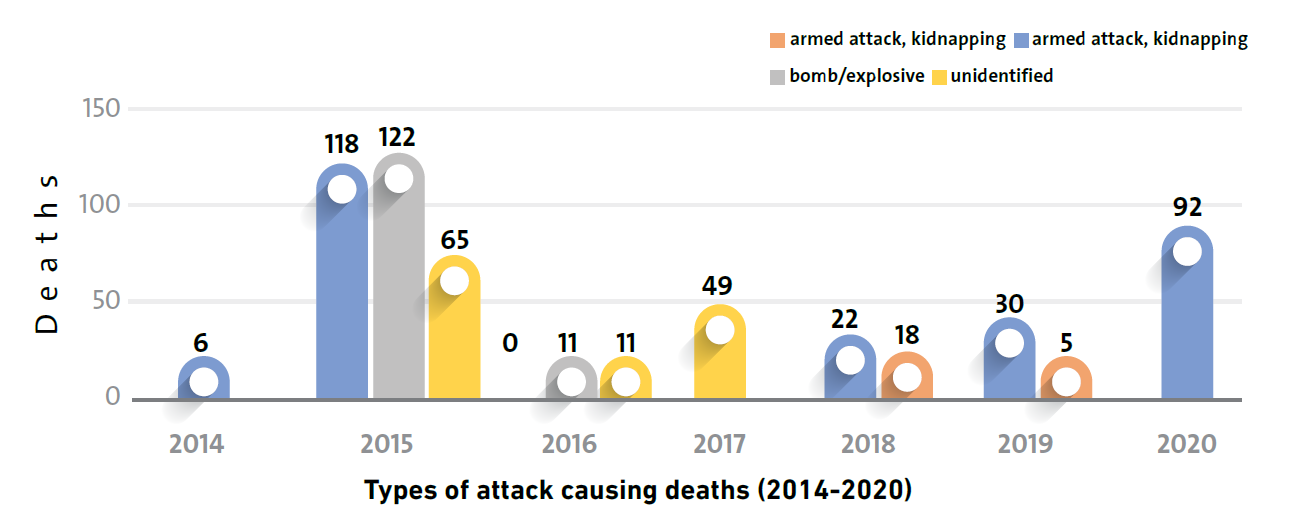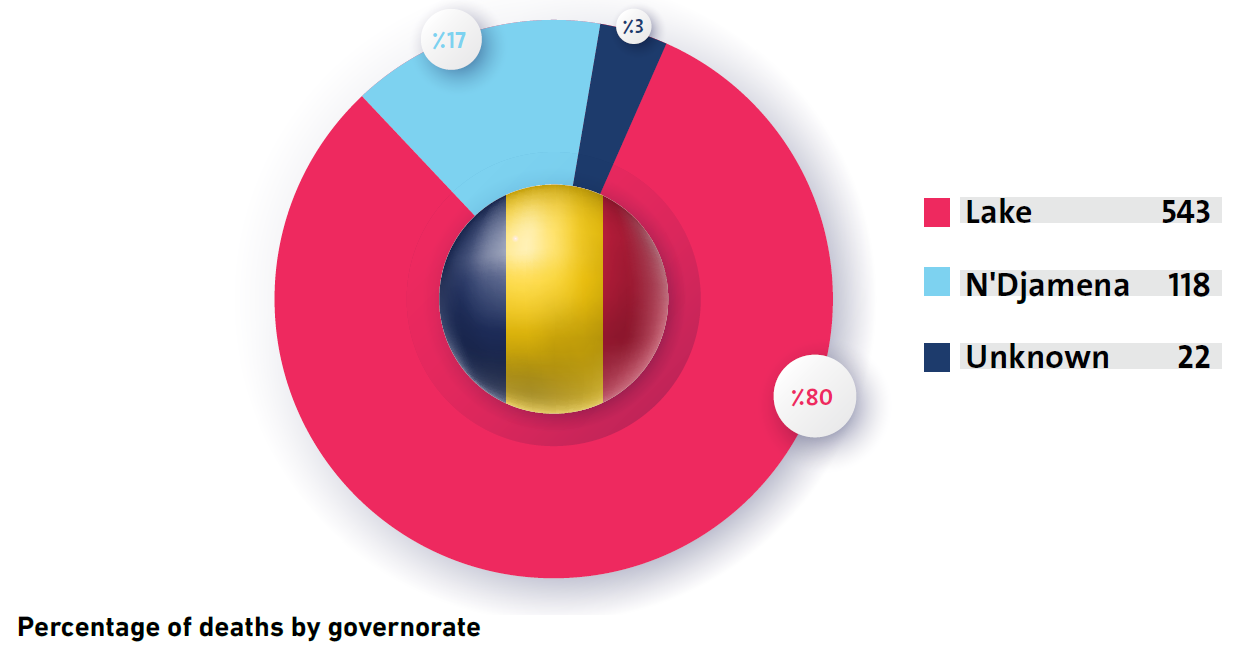When flipping through the history of Chad and replaying the past events, one can understand the deeply sectarian violence perpetrated by groups of local actors alongside Sufi organizations, especially the Senussi movement that was active in the Eastern Sahara in the nineteenth century. The terrorist attacks spearheaded by ISIS take place in West Africa, where Boko Haram rose to prominence, feeding on takfirism and crime as one ideology yoked together. Boko Haram has acted in relay for the historical efficacy of Chad and the sub-region enervated or redirected by imperialism. The term [terrorist attack] used in this text is consistent with the criteria adopted by the National Consortium for the Study of Terrorism, which defines a terrorist act as the threat of violence, or the real use of unlawful violence, by a non-state actor to achieve a political, economic, religious, or social purpose.
DATA
The data used in this research were culled from the website database made available on www.fondapol.com, which included data on terrorist attacks around the world (1979-2019). The scope of work is limited to data on Chad, which has been enhanced by field data. We extracted the daily data from January 2014 to December 2020, which we drew on to develop monthly and annual statistics that enabled us to conduct the said research study. Taken together, we will present the findings revealed.
SEASONAL STUDY
We first researched into the deaths, injuries and attacks being on the increase as reported yearly. The table shows the results of the treatment approach based on the data; in seven years, Boko Haram carried out 50 attacks in Chad, claiming 683 lives and 910 injuries.
Chad became the center for Boko Haram activity, manifested in suicide, insecurity, killing and menace. The statistical graphs show frequency of attacks, number of deaths and injuries, types of attacks, tools used, targets, and region.
2015 recorded the largest number of deaths and injuries; this can be interpreted as a response to the involvement of the Chadian army along with the countries of the sub-region in the fight against the terrorist sect.
Likewise, the use of bombs and improvised explosive devices along with the number of deaths increased in 2015 vis-à-vis other years.
May, June, and July markedly witnessed an increase in attacks that resulted in many deaths. The increase in attacks is partly explained by the rainy season, which makes access difficult to the swampy Lake Chad region. This gives Boko Haram more room for maneuverability.
2014, 2015 and 2020 markedly sustained many deaths; the said years reflect three stages before, during, and after the Chadian military intervention in the war on terrorism. In 2014, Chad became the target, after it had long been a base and a center of operations; Boko Haram stunned Chad by changing its plans. The death toll in 2015 is the result of the Boko Haram attacks, following Chad’s field participation in the regional coalition against terrorism. The attack in 2020 aimed to weaken the group, through the military operations of the countries of the region against Boko Haram. In the 2020 offensive, the military capabilities of Boko Haram put into action are displayed:
The first order of armed attacks and military targets refers to the organization’s raids that are exponentially increasing, which shows its development and expansion for more spread and attacks. The army is the main target of such attacks, as is the case with Al-Qaeda, ISIS, and other terrorist organizations.


Given the vicinity to the epicenter of the crisis alongside the swampy environment, it makes it difficult to gain access to it, the Lake Chad region has become the focus of Boko Haram operations, which has also intensified its attacks in N’Djamena, where it seeks to demonstrate its ability to cause damage outside its stronghold.
PROJECTIONS
Previously, we explored the basic tools of unified and diversified statistics. The database of terrorist attacks in the world (1979-2019) provides big data, which can further help to further explore what the traditional statistical framework can.
The projections for big data processing are also great, and contain new capabilities for exploring information on religious, cultural, and political phenomena. Machine learning is a new method to analyze large databases to automatically process and develop analytical models. The two main methods of machine learning most used are supervised learning, which allows predictability of the variables, and unsupervised learning, which allows an understanding of the database structure.
Terrorism is currently defined by the methods of social sciences and humanities subject to two main logics: military security and development security. It is characterized by description, narration, and analysis of the phenomenon of past and present terrorism. The integral approach represents the social and human sciences, and applied computer sciences, which is seen as an innovative view, seen by analytics and processing blocks of information, allowing for research studies of a predictive nature for events.
RESULTS
Since the outbreak of the security crisis, Lake Chad Governorate has hosted nearly 8,300 refugees, 13,000 returnees, and 124342 displaced people. This situation caused serious consequences for the social structure of the region, which has suffered for several decades because of the war in the country as it was home to some armed opposition movements, such as the Movement for the Liberation of Chad and the Movement for the Defense of Democracy. Being in the crosshairs of Boko Haram, the region is not only witnessing a decline in its agricultural and pastoral potential but has witnessed a steady increase in all the factors of vulnerability and disintegration that already there.
In addition to the disruption of the social balance caused by the mass displacement of the population, the destruction of traditional systems of solidarity, and the emergence of ill values and practices, such as drug trafficking, smuggling light weapons and small arms, the Boko Haram ideology of the Western school seems to have taken root in the region.

Despite the high illiteracy rate, which exceeded 90%, we can argue that the combination of structural and circumstantial factors, such as the anti-Western rhetoric of the Islamic State in West Africa, contributes to the school dropout. The attacks carried out by ISIS have caused a shock that affected all sectors of Chadian society, and the disruption of the land exchange led to the emergence of new hubs that contribute to the high cost of living resulting from the high prices of basic commodities.
Military spending accounted for 6.6% of GDP in 2011 because of the inevitability of fighting terrorism and establishing peace. This is also because of the measures taken by the state to combat extremism and terrorism, including the adoption of the anti-terrorism law, curfews, the deployment of defense and security forces, awareness campaigns, and the establishment of structures to assist victims. Taken together, it has become a financial burden on the state budget, which has been severely affected by the decline in crude oil prices, and the measures adopted in the context of combating the COVID-19 pandemic.
